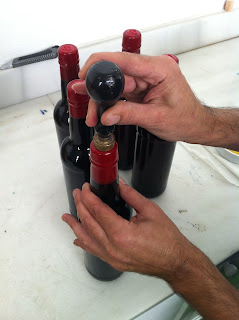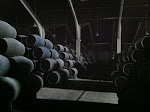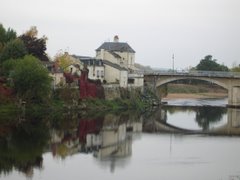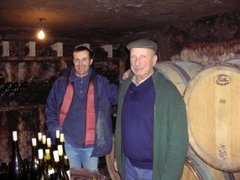Sherry Bodega Visits - Some Highlights
Instead of trying to write about individual visits, I thought it would be fun to summarize a bit and share some highlights.
Emilio Hidalgo was my first visit to a Sherry Bodega. I find it hard to remember the details of a first visit - my senses are always so overwhelmed by the newness of it all. A few things stick out in my mind, however, when I remember the Hidalgo visit. Fernando Hidalgo was our guide, and he and Peter caught up a bit as we walked though the courtyard and into the Bodega - Peter had last been in Jerez in May. The first wine that Fernando poured for us was the very special old Fino called La Panesa, and as he was about to draw wine from a barrel he said "Wait, this is the barrel you tasted last time, Peter. We should taste another barrel." This is impressive. There are obviously many barrels of La Panesa and to remember from which one a rather quiet journalist tasted many months prior...well, it shows an attention to detail and an immersion in one's work that I think is reflected in the wines in general. We tasted several barrels and then walked out of one Bodega and into another.
This is impressive. There are obviously many barrels of La Panesa and to remember from which one a rather quiet journalist tasted many months prior...well, it shows an attention to detail and an immersion in one's work that I think is reflected in the wines in general. We tasted several barrels and then walked out of one Bodega and into another. We passed these tools hanging on the wall. In order to respect Fernando's privacy, I'm not supposed to discuss here what these are actually used for, but I can tell you that it has nothing to do with making wine.*
We passed these tools hanging on the wall. In order to respect Fernando's privacy, I'm not supposed to discuss here what these are actually used for, but I can tell you that it has nothing to do with making wine.* These old barrel parts lay in a courtyard outside of another Hidalgo Bodega. Between this and the tools above, I began to feel as though I better behave myself at Bodegas Emilio Hidalgo.
These old barrel parts lay in a courtyard outside of another Hidalgo Bodega. Between this and the tools above, I began to feel as though I better behave myself at Bodegas Emilio Hidalgo. In the tasting room we sampled several wines from bottle, including the miraculous old Amontillado called El Tresillo. How cool is that old label? This is one of many great wines I drank that is not available in the US, to my knowledge, a real shame.
In the tasting room we sampled several wines from bottle, including the miraculous old Amontillado called El Tresillo. How cool is that old label? This is one of many great wines I drank that is not available in the US, to my knowledge, a real shame. Bodegas Tradición is barely over 10 years old, very new for a Sherry producer. The wines, however, are much older. An old Bodega along with wines of very high quality was purchased by a group including billionaire Joaquin Rivero Valcare. Here is a blog post that describes this story in more detail.
Bodegas Tradición is barely over 10 years old, very new for a Sherry producer. The wines, however, are much older. An old Bodega along with wines of very high quality was purchased by a group including billionaire Joaquin Rivero Valcare. Here is a blog post that describes this story in more detail. We walked through the facilities and I was fascinated by the guy wax-sealing the bottles.
We walked through the facilities and I was fascinated by the guy wax-sealing the bottles. I suppose this is something that happens at wineries all over the world, but it was nice to realize that every bottle of wine that leaves Tradición is sealed in exactly this way.
I suppose this is something that happens at wineries all over the world, but it was nice to realize that every bottle of wine that leaves Tradición is sealed in exactly this way. This is a paper filter. They are stacked together, separated by porous plastic, and this is what some producers use to filter their wines.
This is a paper filter. They are stacked together, separated by porous plastic, and this is what some producers use to filter their wines. I was surprised to learn that this is among the most gentle of filtering techniques. How could that be gentle, wine having to work its way through many layers of plastic and something that feels sort of like paper mâché? Everything is relative, I guess.
I was surprised to learn that this is among the most gentle of filtering techniques. How could that be gentle, wine having to work its way through many layers of plastic and something that feels sort of like paper mâché? Everything is relative, I guess. Before going to the tasting room to sample the wines, we visited the museum. Yes, that's right, there is a museum in the Bodega, filled with master works owned by Mr. Rivero Valcare. The above tile painting is by Picasso at age 8.
Before going to the tasting room to sample the wines, we visited the museum. Yes, that's right, there is a museum in the Bodega, filled with master works owned by Mr. Rivero Valcare. The above tile painting is by Picasso at age 8. We tasted Tradición's four Sherries, a 1975 vintage Oloroso, and their brandies too. I like these wines very much, particularly the Amontillado and the Palo Cortado - another wine that is not available in the US.
We tasted Tradición's four Sherries, a 1975 vintage Oloroso, and their brandies too. I like these wines very much, particularly the Amontillado and the Palo Cortado - another wine that is not available in the US. Peter already described the incredible tasting of the Palmas at González Byass. Another highlight for me at Byass was tasting a barrel of Amontillado wine of indeterminate age, but at least 100 years old. The wine was undrinkable, and Antonio Flores said as much before we tasted it. After enough time in barrel, a wine takes on so much tannin from the wood that it becomes difficult to drink. That said, this wine could be bottled and sold as perfume.
Peter already described the incredible tasting of the Palmas at González Byass. Another highlight for me at Byass was tasting a barrel of Amontillado wine of indeterminate age, but at least 100 years old. The wine was undrinkable, and Antonio Flores said as much before we tasted it. After enough time in barrel, a wine takes on so much tannin from the wood that it becomes difficult to drink. That said, this wine could be bottled and sold as perfume.
I also learned here to rid myself of preconceived notions about the value of mass produced Sherries like Tio Pepe. I'm not saying that I'm stocking up on Tio Pepe, but it is wrong to think that this is bad wine - it is not. González Byass is a grand old Bodega and they have the resources to make very high quantities of Tio Pepe, and quality is consistent. There are other basic Finos that I much prefer, but I would gladly drink Tio Pepe if those are not available, and I think it stacks up pretty well against most of the world's $12 wine. Fernando de Castilla is a small Bodega making high end Sherries. Jan Petterson is a Norwegian who worked for decades at Osborne, and left to take over this gem of a place. I was struck by the fact that he would not pour us samples of his Antique Fino. "I am completely obsessed with flor," he said. "We are very small, and I will not disturb the flor like this. We are entering the season where flor is very delicate and I don't want it to experience any more stress than is necessary." I must say, I admire his dedication to his wines.
Fernando de Castilla is a small Bodega making high end Sherries. Jan Petterson is a Norwegian who worked for decades at Osborne, and left to take over this gem of a place. I was struck by the fact that he would not pour us samples of his Antique Fino. "I am completely obsessed with flor," he said. "We are very small, and I will not disturb the flor like this. We are entering the season where flor is very delicate and I don't want it to experience any more stress than is necessary." I must say, I admire his dedication to his wines. The wine in bottle was lovely, but a bit confusing to me. It is an old Fino, like Inocente or Panesa, and it is higher in alcohol (18%?) than any other Fino I can think of, and I felt it just a little bit on the palate. Or was it the power of suggestion? I wish I could drink it again, but none of Fernando de Castilla's wines are imported in the US. I brought home a bottle of the very special Antique Palo Cortado and I would invite you to taste it with me but alas, I already drank it.
The wine in bottle was lovely, but a bit confusing to me. It is an old Fino, like Inocente or Panesa, and it is higher in alcohol (18%?) than any other Fino I can think of, and I felt it just a little bit on the palate. Or was it the power of suggestion? I wish I could drink it again, but none of Fernando de Castilla's wines are imported in the US. I brought home a bottle of the very special Antique Palo Cortado and I would invite you to taste it with me but alas, I already drank it. Perhaps the highlight of this visit, for me, was tasting Fernando de Castilla's brandies from barrel. We tasted Brandy in its youngest incarnation, throughout the next decade of its life, and then the final product before it is bottled. I actually loved the youngest wine - it reminded me of eau-de-vie in its powerful and delicious fresh fruitiness - it smelled and tasted of ripe pears.
Perhaps the highlight of this visit, for me, was tasting Fernando de Castilla's brandies from barrel. We tasted Brandy in its youngest incarnation, throughout the next decade of its life, and then the final product before it is bottled. I actually loved the youngest wine - it reminded me of eau-de-vie in its powerful and delicious fresh fruitiness - it smelled and tasted of ripe pears.
Our Barbadillo visit was also fascinating. First of all, the wine maker is a woman, which is highly unusual in this part of the wine making world. Her name is Montse Molina and she is originally from Madrid, I believe. So in addition to being a woman, she is also an outsider in Sanlucar, which I imagine must have made it difficult for her in the beginning with the group of men she supervised and collaborated with in making Barbadillo's wines.
Her name is Montse Molina and she is originally from Madrid, I believe. So in addition to being a woman, she is also an outsider in Sanlucar, which I imagine must have made it difficult for her in the beginning with the group of men she supervised and collaborated with in making Barbadillo's wines. We tasted three barrels of Barbadillo's Manzanilla Pasada, each from a different room within one of the Bodegas. These three rooms differed in size, ventilation, and humidity - they produce entirely different wines, in other words. They are eventually blended in order to produce the Manzanilla Pasada that goes into bottle. It was fascinating to taste these three wines in succession, to get a concrete view of the impact of the environment of a Bodega on the barrels of wine it produces. Peter and I took our glasses and blended the three wines in what we thought would be an advantageous way, and it was good. Montse tasted our blend and smiled the way I sometimes smile at my two year old when she is able to get her coat off by herself.
We tasted three barrels of Barbadillo's Manzanilla Pasada, each from a different room within one of the Bodegas. These three rooms differed in size, ventilation, and humidity - they produce entirely different wines, in other words. They are eventually blended in order to produce the Manzanilla Pasada that goes into bottle. It was fascinating to taste these three wines in succession, to get a concrete view of the impact of the environment of a Bodega on the barrels of wine it produces. Peter and I took our glasses and blended the three wines in what we thought would be an advantageous way, and it was good. Montse tasted our blend and smiled the way I sometimes smile at my two year old when she is able to get her coat off by herself. We tasted an old Amontillado and it became instantly clear to me that Amontillado made from Manzanilla is different from Amontillado made from Fino. One is not better than the other, but Manzanilla Amontillado, or at least the few that I've tasted, can have a certain saline and lemon peel brightness that I think is tremendously delicious. These are not easy to find, but worth a special search, if you're into Amontillado. I would suggest that you try Barbadillo's version, which I loved, but it is not imported in the US.
We tasted an old Amontillado and it became instantly clear to me that Amontillado made from Manzanilla is different from Amontillado made from Fino. One is not better than the other, but Manzanilla Amontillado, or at least the few that I've tasted, can have a certain saline and lemon peel brightness that I think is tremendously delicious. These are not easy to find, but worth a special search, if you're into Amontillado. I would suggest that you try Barbadillo's version, which I loved, but it is not imported in the US. And we tasted the Reliquias. These are very old wines, relics, if you will. They are some of the most expensive and rare Sherries, and Barbadillo literally keeps the room where the Reliquias are served under lock and key. And there was some confusion about the location of the key - several workers were sent scurrying about to search for it. Finally it was located, no one was hurt, and in we went. It would be pointless to try to describe the smell and taste of wines as complex as these, but I can tell you that I have never ever tasted an Amontillado as impossibly light and pungent and balanced and beautiful as this one.
And we tasted the Reliquias. These are very old wines, relics, if you will. They are some of the most expensive and rare Sherries, and Barbadillo literally keeps the room where the Reliquias are served under lock and key. And there was some confusion about the location of the key - several workers were sent scurrying about to search for it. Finally it was located, no one was hurt, and in we went. It would be pointless to try to describe the smell and taste of wines as complex as these, but I can tell you that I have never ever tasted an Amontillado as impossibly light and pungent and balanced and beautiful as this one.
What can I say about visiting La Guita and Valdespino with Eduardo Ojeda? Anything I say will trivialize the actual experience of being there with him, listening to him discuss the wines, the Bodegas, the region. He is a passionate, intelligent, an absolutely gentlemanly and lovely person, a living treasure of the wine making tradition in Jerez and Sanlucar. If you go and visit the region, find him and visit La Guita and Valdespino. At both La Guita and Valdespino, Eduardo wanted to show us the progression of the wines from their youth to the Solera, ready to be bottled. This was an incredible experience for me, seeing the wine in various stages of its life. At La Guita we tasted a special barrel, barrel No 3 from the 4th criadera that was just lovely - bright, saline, refreshing, intense.
At both La Guita and Valdespino, Eduardo wanted to show us the progression of the wines from their youth to the Solera, ready to be bottled. This was an incredible experience for me, seeing the wine in various stages of its life. At La Guita we tasted a special barrel, barrel No 3 from the 4th criadera that was just lovely - bright, saline, refreshing, intense. We tasted the barrel that gave us La Bota No 20, and our reaction inspired Cabo, the guy in charge of the Bodega when Eduardo isn't there, to draw off a bottle for us to leave with.
We tasted the barrel that gave us La Bota No 20, and our reaction inspired Cabo, the guy in charge of the Bodega when Eduardo isn't there, to draw off a bottle for us to leave with. We tasted a hidden barrel of Amontillado, that little one above barrel 17, something that is not bottled. This is one of the great things about visiting a Sherry Bodega - if you are lucky you will get to taste special things, wines that the cellar master cares about but that will never see the inside of a bottle. Again, Amontillado made of Manzanilla wine can be very special, and this was absolutely one of the most memorable wines of the trip for me.
We tasted a hidden barrel of Amontillado, that little one above barrel 17, something that is not bottled. This is one of the great things about visiting a Sherry Bodega - if you are lucky you will get to taste special things, wines that the cellar master cares about but that will never see the inside of a bottle. Again, Amontillado made of Manzanilla wine can be very special, and this was absolutely one of the most memorable wines of the trip for me. At Valdespino we tasted through many of the 10 criaderas of Inocente, several criaderas of Tio Diego, and and a few other great wines. Inocente is a Fino that comes exclusively from grapes from the Marchenudo Alto vineyard, one of the "Grand Cru" sites of Jerez. Tio Diego is what happens when Inocente becomes an Amontillado - not 30 years later, but very soon after it becomes Amontillado.
At Valdespino we tasted through many of the 10 criaderas of Inocente, several criaderas of Tio Diego, and and a few other great wines. Inocente is a Fino that comes exclusively from grapes from the Marchenudo Alto vineyard, one of the "Grand Cru" sites of Jerez. Tio Diego is what happens when Inocente becomes an Amontillado - not 30 years later, but very soon after it becomes Amontillado. What happens after Tio Diego? We walked to the section of the Bodega where a few very special wines age in barrel. There is Viejo CP, a lovely Palo Cortado that originates as Inocente, a wine that is not imported in the US. And finally, there is Cardenal, one of the great wines of Jerez, a very old Palo Cortado of which perhaps 400 half bottles are released each year. The Cardenal solera is fed by Viejo CP. As it was first described to me by Peter, "Even seasoned Sherry buffs in Spain widen their eyes if a bottle of Cardenal is served." We tasted this wine next to Coliseo, a very old Amontillado that originates as a Manzanilla, actually. Both are superb wines of astounding depth and intensity, and also great clarity and articulation, and of seemingly unending length. I calculated 47 minutes on Coliseo, but honestly I just stopped counting at that point. These glorious wines are something like the Richebourg and La Tâche of Sherry, but they can be had for a fraction of the price. I should say they could be, if they were imported to the US. I'm starting to sense a pattern here regarding importation, or lack thereof, of fine Sherry. Are you?
What happens after Tio Diego? We walked to the section of the Bodega where a few very special wines age in barrel. There is Viejo CP, a lovely Palo Cortado that originates as Inocente, a wine that is not imported in the US. And finally, there is Cardenal, one of the great wines of Jerez, a very old Palo Cortado of which perhaps 400 half bottles are released each year. The Cardenal solera is fed by Viejo CP. As it was first described to me by Peter, "Even seasoned Sherry buffs in Spain widen their eyes if a bottle of Cardenal is served." We tasted this wine next to Coliseo, a very old Amontillado that originates as a Manzanilla, actually. Both are superb wines of astounding depth and intensity, and also great clarity and articulation, and of seemingly unending length. I calculated 47 minutes on Coliseo, but honestly I just stopped counting at that point. These glorious wines are something like the Richebourg and La Tâche of Sherry, but they can be had for a fraction of the price. I should say they could be, if they were imported to the US. I'm starting to sense a pattern here regarding importation, or lack thereof, of fine Sherry. Are you?
* Patently false. These are wine making tools. And Fernando Hidlago is an upstanding citizen who is well regarded in his community.






















































